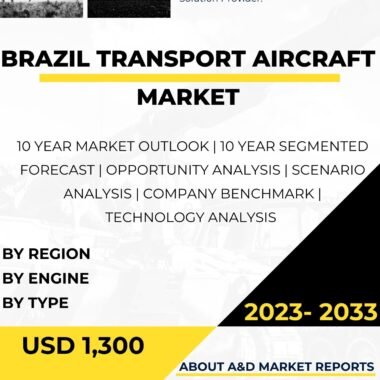Description
The Australia transport aircraft market holds significant importance for the nation’s defense and aerospace industries, enabling the efficient movement of troops, cargo, and humanitarian aid across vast distances and challenging terrains. As a geographically diverse country with remote regions and vast coastlines, Australia relies on transport aircraft to maintain its national security, support disaster relief operations, and engage in international peacekeeping missions. The growth and development of the Australia transport aircraft market have been shaped by various factors, including defense modernization efforts, strategic alliances, indigenous development, technological advancements, and the country’s commitment to humanitarian assistance.
Australia’s defense modernization initiatives have been instrumental in driving the growth of its transport aircraft market. The country recognizes the strategic significance of having a capable and agile air mobility fleet to support its defense forces. As the geopolitical landscape evolves, Australia seeks to enhance its rapid deployment capabilities and improve its ability to respond to emerging security challenges in the Indo-Pacific region. This focus on defense modernization has led to the acquisition of advanced transport aircraft capable of meeting the diverse operational requirements of the Australian Defense Force (ADF).
Strategic alliances and defense partnerships with other nations have played a vital role in bolstering Australia’s transport aircraft market. Collaborations with key allies, such as the United States and other Indo-Pacific nations, have allowed Australia to access advanced transport aircraft and benefit from knowledge sharing and interoperability initiatives. These partnerships not only strengthen Australia’s defense capabilities but also foster cooperation and mutual support in joint military and humanitarian operations.
Indigenous development has been a significant driver of growth in the Australia transport aircraft market. The country’s defense industry actively invests in research and development initiatives to design and manufacture transport aircraft that cater to Australia’s specific needs and operational requirements. Indigenous development not only reduces reliance on foreign suppliers but also promotes technological advancements and supports the growth of the domestic defense industry.
Technological advancements have played a pivotal role in shaping the Australia transport aircraft market. Modern transport aircraft are equipped with advanced avionics, navigation systems, and communication capabilities, enhancing their operational flexibility and efficiency. These technological advancements enable transport aircraft to conduct a wide range of missions, including aerial refueling, medical evacuations, disaster relief, and troop transportation.
The need for humanitarian assistance and disaster relief operations has driven the demand for versatile transport aircraft in Australia. The country is prone to natural disasters, such as bushfires, floods, and cyclones, which necessitate rapid and effective responses. Transport aircraft are vital in delivering emergency supplies, medical equipment, and personnel to affected areas, showcasing their critical role in supporting Australia’s disaster management capabilities.
Australia’s extensive coastline and remote regions pose unique logistical challenges, making transport aircraft an indispensable asset for connecting and supplying distant locations. The ability to quickly and efficiently transport personnel, equipment, and supplies across vast distances is crucial for Australia’s defense readiness and national security.
The integration of advanced transport aircraft into Australia’s defense and aerospace capabilities aligns with the country’s strategic objectives. As Australia aims to maintain a credible presence in the Indo-Pacific region and contribute to international peacekeeping efforts, a robust transport aircraft fleet becomes essential. Transport aircraft enable the ADF to conduct global operations, deliver humanitarian aid, and participate in multinational exercises and peacekeeping missions.
The role of transport aircraft extends beyond military operations; they also play a critical role in supporting civilian needs, such as aerial firefighting, search and rescue operations, and medical evacuations. The versatility of transport aircraft allows them to serve both defense and civilian purposes, making them invaluable assets for the country’s overall security and safety.
Australia’s investment in the transport aircraft market aligns with its defense export goals. The country’s capability to operate and maintain a fleet of advanced transport aircraft enhances its reputation as a reliable provider of air mobility solutions. As a result, Australia has the potential to export its transport aircraft and aviation services to international partners, contributing to the growth of its defense industry and strengthening its economic ties with other nations.
In conclusion, the Australia transport aircraft market plays a vital role in supporting the nation’s defense and aerospace capabilities. The growth and development of this market are driven by defense modernization efforts, strategic alliances, indigenous development, technological advancements, and the country’s commitment to humanitarian assistance. As Australia seeks to maintain its national security, respond to natural disasters, and engage in international peacekeeping missions, the role of transport aircraft becomes increasingly critical. Through partnerships, indigenous development, and technological advancements, Australia is well-positioned to meet its air mobility needs and maintain its presence as a key player in the Indo-Pacific region. The continued investment in transport aircraft capabilities reflects Australia’s commitment to ensuring the safety, security, and well-being of its citizens and its commitment to supporting global peace and stability.




